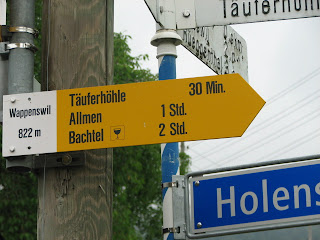My good friend Harry, a loyal Presbyterian pastor, and I used to have coffee and talk about church and theology and other important stuff. We affirmed that we agreed on the really important things, like Jesus and salvation by grace. We also recognized our differences on a few topics like baptism. Never once, however, to my knowledge, did Harry feel the need to drown me nor did I feel like I should run for my life.
500 years ago good men were dying over this issue. These men believed strongly in their freedom to read and interpret Scripture for themselves; they believed they should be able to preach the Word freely and be allowed to follow God, not the Church or the priests.
And they were declared outlaws. Harsh, violent persecution was directed at them by the Protestant Reformers. Where we have been recently, we have visited some of the places in and near Zurich where Anabaptists hid, were imprisoned, and executed.
We went to the "Anabaptist Cave" outside of Zurich, near a tiny village in the country. We walked eight or nine kilometers from the bus stop on a road that ran through lush green pastures. The rolling hills, the bucolic scenery, the music in the air (yes--there really is music in the air in the Swiss countryside. Every cow has a bell attached to a strap around its neck. As the cows graze, those bells ring in harmony! There are no minor or discordant notes! You can hear them from across the valley. How do they do that?)--it is almost magical.
Anyway, the road turns into a trail which begins to ascend a slope up into the dark forest. Fortunately there are trail markers and at one juncture, just before the trail turns up really steeply, there is a large sign that describes the Anabaptists, their conflict with the Reformers, their subsequent persecution and their flight into hiding.
The forest really is deep and dark. The trail winds up alongside a stream. Then, just ahead, the cave comes into view. It has a large opening. The stream drops from the cliff directly above and cascades straight down in front of the cave mouth into the valley below. The cave is larger than it appears--could probably hold 80-100 people. The roof drops as it goes back but there is still enough headroom to go back about 40 meters.
People obviously spent time here, hiding from officials who had confiscated their farms and belongings and now sought to arrest them and take them back to town for trial as heretics. In the 1830s, in niches deep inside the cave, knives, forks, spoons, and thimbles were discovered.
At this point, in 1525, Protestant Reformers are not only fighting Catholics but they are hunting and killing "radicals." Catholics are fighting Reformers and also hunting the Anabaptists. Anabaptists are wanting to read Scripture for themselves and baptize believers instead of infants, which is what they believed the Bible teaches. They are also non-violent--they will not fight back and they are willing, if caught, to go to their death for their belief.
The fields are so verdant. Mist hangs low over the hills. We are walking on a paved road from town. The road changed from pavement to gravel to pasture path to forest trail.
Not entirely certain we are on the right path (even though Google maps is really helpful), we finally come to an intersection and this small sign. The top listing is for the Tauferhohle, the "Anabaptist cave." The place actually was later referred to derisively by a local state church preacher as the "Anabaptist Hole."
Two lovely ladies pose in front of the sign that had been put in place just where the trail turns steeply uphill. This sign is evidence that the State Church and the Anabaptists (in Europe, the Mennonite Conference) are at least trying to make nice. They jointly installed the sign in the middle of this decade.
This picture and the next one describe the Anabaptist situation in the early 1500s. It is not really easy to read (but hey, the forest was dark and the day was cloudy, the light was shifting) but at least it is in English. I figured this was easier than my trying to reproduce what it says.
The heading is "The First Worldwide Anabaptist Community."
Here go those ladies bravely up the hill in search of the cave.
You know those cows I mentioned? We could hear them all the way across this valley. If you look closely, you can see them in the center-right of the picture. The sound of their bells, however, was clear and ringing.
The forest trail led up to the cave. I think that in the 16th century they probably did not have handrails. Better for us, however, because the drop-off into the valley to the right is quite steep.
The first glimpse of the cave opening. It is much bigger than it appears from here. Handrails and a few benches have been set in the hard, packed floor of the cave.
In the semi-darkness of the cave, you can just see this sign which has been bolted to the ceiling. I have a picture of it using my flash, which makes it look golden and bright. This photo is a more accurate depiction of how it appears. It reads, "This is the place where the Anabaptists met in the 16th century looking for shelter, for quietness, and for prayer."
This is the view from the cave looking out into the valley below. It would indeed be a remote sheltered place. I could imagine sitting here, listening to Felix Manz as he encouraged the refugees and taught them from the Scripture. I could also imagine being a kid who could not fully understand what was going on but was entranced by the beauty and mystery of the forest behind the speaker as well as the steadily flowing waterfall which added its magical, mesmerizing sound to the scene. (You can see the small water fall--it appears as a vertical shaft, gossamer and ephemeral, just to the right of center.)
Like I said, I could imagine . . . . . . . ."Be strong," he would say, "Stay the course. God is with you. Do not fight back but keep the faith, all the way to the end."













I'm curious. Did it look like the "Anabaptist Cave" got much tourist traffic? Your description of the countryside is gorgeous. Quite poetic! It does make me wonder whether the bells are made in only certain sizes, so the notes are never discordant... A quick google search came up with nothing on that, but I did find out that the traditional Swiss cowbell is called the trychel.
ReplyDeleteIs it really worth dying for the right to be re-baptized? I understand that this was also a symbol for all the other theological stances, which I do think are worth dying for, like "freedom to read and interpret Scripture for themselves" and the freedom "to preach the Word freely and [...] to follow God, not the Church or the priests." But rebaptism in and of itself. Is that worth dying for? I don't think so. Or should I not think that? Should we always be willing to die for something we know God to have commanded?
I find it unfortunate that the name for this group is derived solely from this stance. It is the other stances that are so much more important, in my mind. Of the modern Protestant groups, which ones still practice infant baptism? Would you say there are more which practice a "believer's baptism"? Are there Protestant groups which began practicing infant baptism and then moved away from that over time?
Perhaps it was not the small things they were willing to die for. Simply the right to worship and belive as they saw fit. Not the right to use bread instead of a cracker.
DeleteWhat a splendid place for a walk! Were you able to get pictures of this idyllic countryside? :D I would sure love to see the cave and the waterfall… I didn’t expect there to be much signage for the Anabaptist sites – is knowledge of them more widespread in their historic stomping grounds than it is in the States?
ReplyDeleteWow! That's beautiful! Thank you for sharing those pictures! I wonder if their beautiful surroundings helped remind them of God during the persecution.
ReplyDeleteIt's so very beautiful there - it would sure bring a lot of peace to those persecuted folks. How great!
ReplyDelete